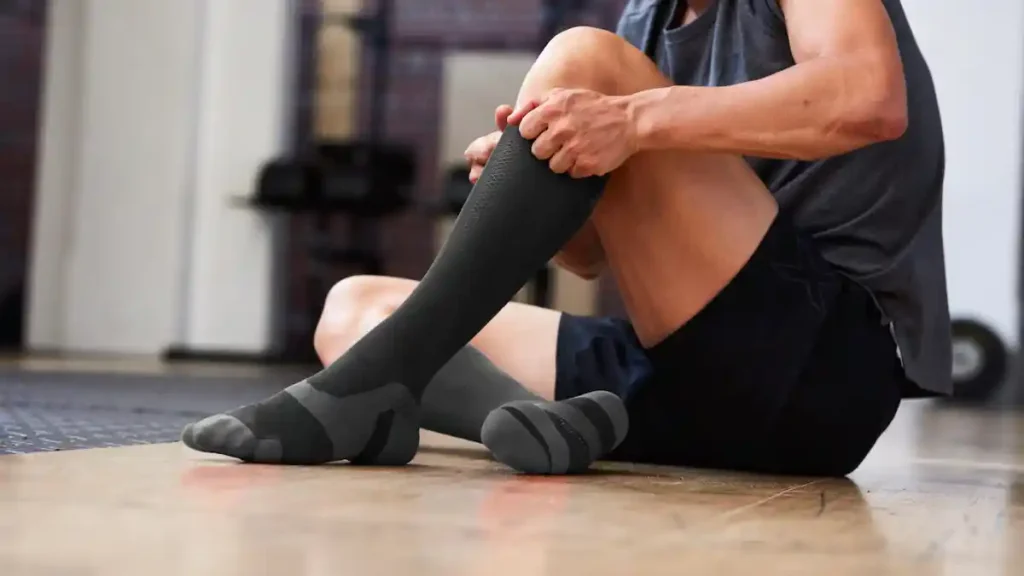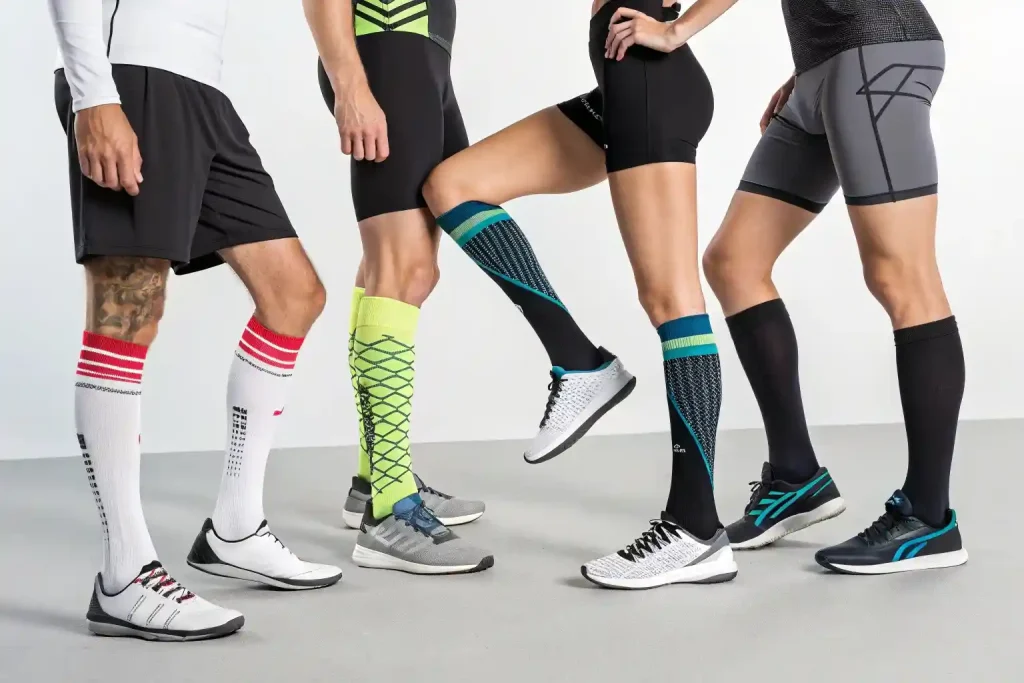Compression stockings are a must-have for many people, helping with everything from reducing swelling to improving blood circulation. Whether your customers are athletes, office workers, or frequent travelers, these stockings provide key health benefits. But putting them on can sometimes be a struggle, especially for first-time users. Getting the fit right is crucial for comfort and effectiveness.
In this guide, we’ll share simple and practical tips to make wearing compression stockings easier for your customers. With these easy steps, you can help your customers enjoy all the benefits these stockings offer, while making the process hassle-free.
Understanding the Different Types of Compression Socks
- Progressive Compression Socks vs. TED Hose
Compression socks come in different styles to serve various needs. Progressive compression socks provide the most pressure at the ankle, gradually decreasing as they move up the leg. This design promotes better circulation, making them ideal for everyday use, especially for those with varicose veins or swelling. On the other hand, TED hose (Thromboembolic Disease hose) are typically used in medical settings, especially after surgery. They focus on maintaining blood circulation and reducing the risk of blood clots while the patient is immobile. Understanding the difference will help you guide your customers to choose the right sock for their needs.
- Selecting the Right Compression Level
When choosing the right type of compression sock, it’s essential to consider the pressure level. Low compression (less than 20 mmHg) is ideal for those who want light support for everyday activities, such as office workers or travelers. Medium compression (20-30 mmHg) provides a stronger effect and is typically recommended for individuals with conditions like mild varicose veins or swelling. High compression (30-40 mmHg or higher) is for those with more severe symptoms, like deep vein thrombosis or significant swelling. Knowing these pressure levels allows you to better assist your customers in selecting the right option for their needs.
How to Choose the Perfect Compression Socks

- Choosing the Right Pressure Level for Your Needs
When selecting the right compression sock, it’s crucial to consider the wearer’s health condition. For those with mild leg fatigue or discomfort, low-pressure options (under 20 mmHg) are sufficient. Medium-pressure socks (20-30 mmHg) are best for those dealing with varicose veins or swelling from long periods of sitting or standing. Higher pressure socks (30-40 mmHg or above) are typically used for more serious issues like deep vein thrombosis or severe swelling. Understanding these health needs will help ensure that your customers choose the right pressure level to experience optimal relief.
- Sizing Tips for a Comfortable Fit
The perfect fit is essential for compression socks to work effectively. To achieve this, your customers need to measure their legs correctly. Start by measuring the circumference of the ankle, the widest part of the calf, and the length of the leg from the foot to just below the knee or thigh. These measurements will help determine the correct sock size and ensure that it provides the necessary pressure. A well-fitted sock prevents discomfort and ensures better circulation, giving your customers the relief they need.
Step-by-Step Guide to Putting On Compression Socks
Step 1: Sit Down, Hold the Heel, and Turn the Sock Inside Out
To begin, find a comfortable sitting position. Hold the heel of the compression sock and turn it inside out, leaving just the toe section outside. This will make it easier to slide your foot in and will ensure the sock fits properly without any pressure points.
Step 2: Slide Your Foot In, Align the Heel, and Pull Up Slowly
Gently slide your foot into the sock, making sure the heel of your foot aligns with the heel of the sock. Once your foot is in, slowly pull the sock up your leg, adjusting it as you go to ensure even pressure distribution. Take your time to avoid rushing, as this will help with comfort and effectiveness.

Step 3: Smooth Out Wrinkles for a Snug, Comfortable Fit
As you pull the sock up, make sure to smooth out any wrinkles or folds that may form. A smooth, wrinkle-free fit ensures that the sock will stay in place and provide the optimal compression needed for comfort and circulation. Make sure the sock is snug but not too tight, offering the right balance of support without discomfort.
Tools That Help Customers Wear Socks Without Struggles
Rubber Gloves: Improves Grip for Pulling Socks Up
Rubber gloves can be a simple yet effective solution for making it easier to put on compression socks. By increasing grip, gloves allow users to pull the socks up without straining, especially when dealing with tight-fitting designs. This is particularly helpful for customers who may struggle with their hands or have limited strength. Encouraging your customers to use rubber gloves can make the process quicker and more comfortable.
Plastic Bag Trick: Cut a Hole, Slide the Sock Over the Bag, and Remove
Another handy trick involves using a plastic shopping bag to help slide the sock on smoothly. Simply cut a hole in the bag, stretch it over the sock, and slide the foot in. As the sock is pulled up, the bag will help it glide over the leg with ease. Once the sock is in place, the bag can be removed. This method is especially useful for people who find it difficult to grip or adjust the socks without extra assistance.
Special Donning Aids: High-Quality Tools for Elderly or Less Mobile Users
For elderly or less mobile customers, specialized donning aids are invaluable. These tools are designed to help users put on compression socks with minimal effort, reducing strain on their hands and back. They come in various forms, from simple assistive devices to more advanced options that offer greater ease for individuals with mobility challenges. Offering these aids to your customers can enhance their experience and ensure they can wear their compression socks comfortably and independently.
Common Mistakes to Teach Customers to Avoid
- Rolling Socks Up: Damages Elastic and Reduces Lifespan
One common mistake is rolling compression socks up instead of pulling them up properly. This can stretch and damage the elastic material, causing the socks to lose their effectiveness and wear out much faster. Encourage your customers to always pull the socks up gently without rolling them to maintain the compression and extend their lifespan.
- Wrong Size: Too Tight or Loose Socks Cause Discomfort
Wearing the wrong size is another issue that can lead to discomfort. If the socks are too tight, they can pinch or restrict blood flow. On the other hand, if they are too loose, they won’t provide the intended support, and your customers may not experience the full benefits. Make sure to educate your customers on the importance of getting the right fit based on their measurements for both comfort and effectiveness.
- Ignoring Seams: Misaligned Seams Lead to Blisters or Pain
Seams that aren’t aligned properly can cause irritation, blisters, or unnecessary pressure points. It’s important to make sure the seams are positioned correctly to avoid discomfort during wear. Advise your customers to adjust the socks carefully, ensuring the seams run smoothly along the leg, to avoid pain and ensure the best fit.
Why Custom Compression Sock Designs Win Customer Loyalty
- Perfect Fit: Tailored Sizing for Enhanced Comfort
Offering custom-designed compression socks allows you to provide products that cater to a wide range of body types and preferences. By offering various sizes and styles, you can ensure a better fit for your customers, enhancing their comfort and satisfaction. This personalized approach demonstrates your commitment to meeting diverse customer needs, fostering trust and loyalty.

- Special Materials: Stretchy, Breathable Fabrics for Easier Wear
Incorporating stretchy, breathable materials into your custom designs significantly improves the wearing experience. Fabrics that adapt to the wearer’s movements and allow air circulation reduce discomfort and skin irritation. Customers are more likely to remain loyal to brands that prioritize their comfort and well-being, making material selection a crucial factor in product development.
- Your Brand’s Edge: Offer Unique Colors or Patterns for Different Needs
Customizing compression socks with unique colors or patterns provides an opportunity to cater to diverse customer preferences and needs. Whether it’s for athletic performance, medical requirements, or fashion statements, offering a variety of designs allows customers to select products that resonate with their personal style and purpose. This variety not only differentiates your brand in the market but also strengthens customer attachment and loyalty.

Why Partner with Our Factory for Compression Sock Success?
Create Tailored Designs That Meet Customer Needs
You’ll benefit from custom compression socks crafted to address specific use cases—medical-grade gradations for post-surgery patients, breathable athletic designs for runners, or stylish options for office professionals. Our factory adapts pressure levels, materials (like antimicrobial fabrics), and seamless knitting techniques to reflect your brand’s vision, ensuring your products stand out in crowded markets.
Scale Profitably with Bulk Compression Sock Orders
Maximize margins without compromising quality. We offer competitive pricing for large-volume purchases, whether you’re supplying healthcare providers, retailers, or direct-to-consumer brands. Fast turnaround times and flexible minimum order quantities (MOQs) let you respond swiftly to trends like seasonal demand for travel-ready styles.
Rigorous Quality Control Meets Global Standards
Your brand gains peace of mind with compression socks manufactured under ISO-certified processes and compliance with FDA/CE medical guidelines. We conduct multi-stage inspections—from raw materials to finished products—to ensure every pair meets AQL quality benchmarks.
Advanced Machinery for Precision Compression Sock Production
We invest in state-of-the-art knitting machines and medical-grade equipment to produce seamless, gradient-pressure designs. Automated systems minimize human error, guaranteeing consistent sizing and compression accuracy across bulk orders.
Conclusion
Offering custom-designed compression socks allows you to meet your customers’ unique needs, enhancing their comfort and satisfaction. By providing tailored sizing, high-quality materials, and exclusive designs, you can set your brand apart and build lasting customer loyalty. Ready to take the next step? Contact us today to explore how our manufacturing expertise can bring your custom compression sock designs to life, ensuring your customers receive products that truly meet their needs.
FAQs
Do you offer designs for niche markets like corporate wellness programs?
Yes. Customizable patterns (subtle logos for offices or vibrant styles for gyms) cater to specific audiences, aligning with your brand’s focus areas.
Which materials do you recommend for breathable compression socks?
We use moisture-wicking nylon blends and antimicrobial bamboo fibers, ideal for athletes or healthcare workers requiring all-day comfort.
Do you offer eco-friendly packaging for bulk orders?
Yes. Customizable recyclable boxes or biodegradable wraps align with sustainability goals while protecting products during shipping.
How do you ensure compliance with global safety standards?
Every batch undergoes ISO-certified inspections, with documentation provided for FDA, CE, and other regional certifications.
Are there minimum order quantities (MOQs) for custom compression sock designs?
Yes, but our flexible MOQs start at 500 pairs to accommodate startups and established brands alike.
